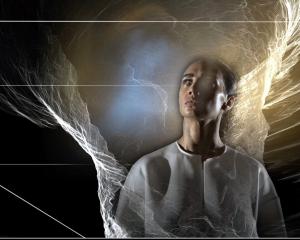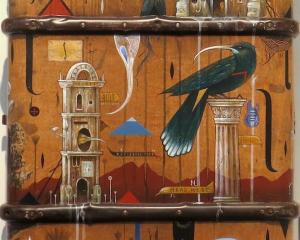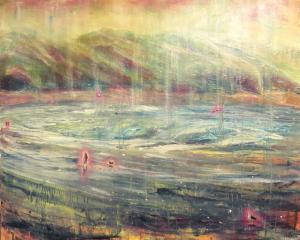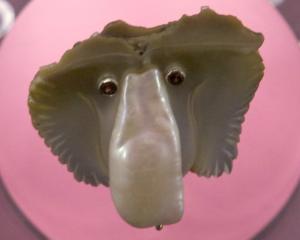In this week's Art Seen, James Dignan looks at exhibitions from Mark Braunias, the Rayner Brothers, and Frank Gordon.
 Untitled, by Mark Braunias
''Working on a Guru (A Pictorial Procession)'', Mark Braunias (Otago Polytechnic School of Art)
Untitled, by Mark Braunias
''Working on a Guru (A Pictorial Procession)'', Mark Braunias (Otago Polytechnic School of Art)

''Working on a Guru'' is a impressive, bold, and darkly humorous reworking of chapel frescoes by Giotto. Giotto's frescoes, depicting the life of Christ and the Last Judgement, have inspired Braunias's images of humanity's decline and rush towards self-destruction.
Many of the side wall works are untitled, or titled with bland platitudes, motivational phrases, or what the artist calls ''cranky proverbs''. Between these expressionistic, semi-abstract scrolls is a lone desk adorned with the paints and tools of the artist's dark craft, and positing the question ''are you one of us?''.
Whether the ''us'' refers to artists, worshippers, or the headlong rat-race of humanity is left to the viewer to decide.
The two end walls are secular analogues of the Last Judgement and Last Supper. In the Last Supper, two letters, ''I.N.'' (for Jesus of Nazareth) sit over a chaos of forms suggesting the human race as suicidal consumer, devouring both home and self.
From the other end of the room, The Grateful Dead sit in judgement - a collection of hand-coloured photographs and typed obituaries of the rich and famous, arranged alphabetically and thereby forming weird juxtapositions (Hitler and Philip Seymour Hoffman, JFK and Captain Kidd) as if to underline that everyone, good, bad, or otherwise, must suffer the same eventual fate.
 Rainbow Bear, by Mark Rayner
''Rayner Brothers Circus'', Mark and Paul Rayner (Olga)
Rainbow Bear, by Mark Rayner
''Rayner Brothers Circus'', Mark and Paul Rayner (Olga)

The Rayner Brothers, Mark and Paul, have plundered iconic images in a humorous and occasionally dark exhibition at Olga. The artist's ''low-brow high-art world'' consists of reappropriated kitsch decorations, ceramics, miniature hand-woven rugs, and photoshopped photographs, ranging in subject from Donald Duck to David Bain.
There is a wealth of inventiveness in the art, which includes the depiction of Jacinda Ardern as a religious icon with sacred heart through to money boxes designed as gold coins rising from a mound of excrement.
The subject matter and its treatment at times suggests a political narrative, but the sense is more one of reappropriation of cultural items for use in a humorous low-brow context, the substantial physical equivalent of internet memes.
Among the most attractive pieces on display are several ceramic plates, hand-painted with ''sick monkeys'' (by Mark) and a camouflage-pattern portrait of Andy Warhol (by Paul). Mark's impressive latch-hook rugs are also very pleasing.
From a local viewpoint, perhaps the most controversial items are two David Bain teapots, collaborative works by the brothers.
These depict the Dunedin cause celebre in ceramic form, each with a cosy reminiscent of his infamously patterned jerseys. As with Bain, this exhibition will find both supporters and detractors, but either way it is well worth a look.
 Windswept, by Frank Gordon
''Little Wonderland'', Frank Gordon (Gallery De Novo)
Windswept, by Frank Gordon
''Little Wonderland'', Frank Gordon (Gallery De Novo)

Frank Gordon's ''Little Wonderland'' exhibition lives up to its title, with only a small number of works, yet it is no less welcome for that.
Unlike Gordon's other recent exhibitions, this display does not directly depict a magic-realist present-day Dunedin, full of larger-than-life characters going about extraordinary lives. Instead, he has depicted Dunedin and its surroundings at the whim of the forces of nature, and most specifically in a mythical future where we have been forced to reacquaint ourselves with a world changed by global warming, and where the natural world has reasserted itself in giant form. Houses perch high in gargantuan trees, or are nestled within the feathers of behemoth birds.
This future world has elements which, at first, seem believable if unusual, and then jarringly odd in a way only possible in dreams. The watered-bound, moss-covered walls of the former Chief Post Office building appear in New Dunedin, for example, but a closer inspection reveals tiny houses, surely less than a metre in height, clustered around the building.
These odd elements are, however, perfectly consistent with dream narratives, and it is definitely a dream world that the artist is depicting in scenes such as New Dunedin and the delightful harbourside treehouses of Utopia.





![... we all become all of these things [installation view] (2025), by Megan Brady.](https://www.odt.co.nz/sites/default/files/styles/odt_landscape_small_related_stories/public/story/2025/03/1_we_all_become_all_of_thes.jpg?itok=nicA_yAm)


![Poipoia te Kākano [installation view]. Allison Beck, Megan Brady, Kate Stevens West, Jess...](https://www.odt.co.nz/sites/default/files/styles/odt_landscape_small_related_stories/public/story/2025/02/1_poipoia_te_k_kano.jpg?itok=ssJ8nxyx)



